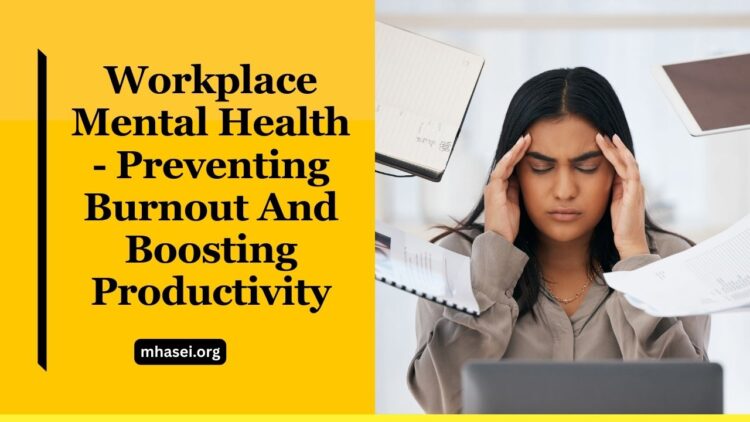In today’s fast-paced business environment, workplace mental health has become a critical factor for both employee well-being and company success.
Rising workloads, hybrid schedules, and economic pressures are leaving employees more vulnerable to burnout, which not only affects individual performance but also impacts organizational productivity.
Companies that invest in mental health support are not just promoting wellness—they are also creating stronger, more resilient workforces.
What Is Burnout?
Burnout is a state of chronic workplace stress that manifests in three main ways:
- Exhaustion – feeling physically and emotionally drained
- Cynicism – growing detachment from work or colleagues
- Reduced productivity – declining motivation and effectiveness
Unchecked burnout can lead to higher absenteeism, more errors, and lower engagement, making it a costly issue for organizations.
Why Businesses Should Care
- Lower productivity: Burnout reduces efficiency, creativity, and focus.
- Higher turnover: Employees experiencing burnout are more likely to resign.
- Financial costs: Lost productivity, recruitment, and healthcare expenses accumulate quickly.
- Reputation risks: Companies that ignore mental health struggle to attract and retain top talent.
Supporting mental well-being is no longer optional; it’s essential for sustainable business growth.
How to Prevent Burnout and Boost Productivity
1. Redesign Workloads and Schedules
Overloaded employees are at the highest risk of burnout. Companies can address this by:
- Implementing realistic workload planning
- Reducing unnecessary meetings and emails
- Offering flexible work hours or compressed workweeks
- Encouraging use of vacation days and proper rest
Organizations that trial shorter workweeks often report higher output and lower stress levels.
2. Strengthen Managerial Support
Managers play a pivotal role in employee engagement. Training them to:
- Recognize early signs of burnout
- Communicate openly about workload challenges
- Encourage regular check-ins and recognition
- Create psychologically safe environments
Strong leadership ensures employees feel supported, valued, and heard.
3. Expand Access to Mental Health Resources
Providing access to mental health care reduces absenteeism and increases productivity. Effective measures include:
- Employee Assistance Programs (EAPs)
- On-demand counseling or therapy sessions
- Workshops on stress management and resilience
- Confidential helplines and wellness apps
When employees know help is readily available, they are more likely to seek support early.
4. Normalize Recovery and Balance
Encouraging a healthy work-life balance fosters long-term productivity. Companies can promote:
- Regular breaks during the workday
- Time-off policies that discourage after-hours communication
- Health and wellness programs, such as mindfulness sessions or fitness initiatives
- Clear boundaries between personal and professional time
These small cultural shifts help employees recharge and return more focused.
Quick Facts & Figures
| Metric | Insight |
|---|---|
| Global engagement rate | Around 1 in 5 employees are fully engaged |
| Cost of disengagement | Trillions lost annually due to low productivity |
| Impact of strong managers | Directly linked to higher engagement and output |
| Effect of flexible schedules | Reduces burnout and improves job satisfaction |
| ROI of mental health programs | Positive return—lower turnover and absenteeism |
Implementation Roadmap (90 Days)
Weeks 1–2:
- Conduct employee surveys to measure stress and burnout risks.
- Audit workloads and meeting schedules.
Weeks 3–6:
- Train managers to spot burnout warning signs.
- Introduce clear after-hours communication guidelines.
Weeks 7–12:
- Pilot flexible scheduling or shorter workweeks in select teams.
- Expand access to mental health programs and track engagement.
Ongoing:
- Review metrics quarterly: absenteeism, turnover, engagement scores.
- Continuously refine strategies based on employee feedback.
Preventing burnout and supporting mental health is both a moral and business imperative. Organizations that prioritize well-being through workload redesign, supportive leadership, flexible schedules, and accessible resources see stronger employee engagement and long-term productivity gains.
In 2025 and beyond, companies that invest in workplace mental health will not only safeguard their people but also gain a competitive edge in performance and innovation.
FAQs
What are the earliest signs of workplace burnout?
Early signs include constant fatigue, irritability, reduced focus, and decreased enthusiasm for work tasks. Spotting these indicators early allows for quick intervention.
Do flexible work arrangements really improve productivity?
Yes. Flexible schedules and shorter workweeks consistently show reduced burnout, improved job satisfaction, and in many cases, even higher productivity.
How can companies measure the ROI of mental health programs?
By tracking absenteeism, turnover, healthcare claims, and employee engagement before and after program rollout, businesses can calculate financial returns.




